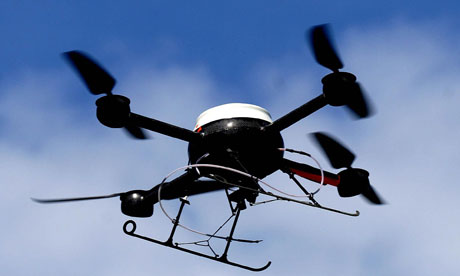Companies seeking to enable the routine use of surveillance drones across Britain are planning a long-term public relations effort to counter the negative image of the controversial aircraft.
The Unmanned Aerial Vehicle Systems Association (UAVSA), a trade group that represents the drone industry to the UK government, has recommended drones deployed in Britain should be shown to "benefit mankind in general", be decorated with humanitarian-related advertisements, and be painted bright colours to distance them from those used in warzones, details from a UAVSA presentation show.
Plans are also under way to establish corridors of segregated airspace to fly drones – or UAVs – between restricted "danger zones" (airspace where test flights take place) in isolated parts of England and Wales.
A series of presentations given by industry figures in recent months show public opposition is considered a major hurdle. UAVSA has discussed how it could use the media to disseminate favourable stories, creating a narrative that presents the introduction of drones in the UK as part of a "national mission".
A talk three months ago at the Royal Aeronautical Society by Colin Burbidge, UAVSA's head of information services, cited the website Drone Wars UK as an example of the negative publicity the industry must overcome. Drone Wars documents the use of drones in conflict zones and features a database of more than 80 UAV crashes around the world dating back four years.
Chris Cole, the Drone Wars founder, accused the industry of trying to undermine "genuine public debate" about the use of UAVs in Britain. "They know the public don't like it," Cole told the Guardian.
John Moreland, the general secretary of UAVSA, said the industry was uncomfortable with the word "drones" and wanted to find new terminology. "If they're brightly coloured, and people know why they're there, it makes them a lot more comfortable," he said.
"We want to be associated with safe, civil applications [of UAVs] that have a humanitarian, ecological and environmental benefit."
Another UAV consortium, Astraea, which includes the arms manufacturerBAE Systems, has been advised by airspace regulator the Civil Aviation Authority (CAA) to "paint a more positive picture" of drones to combat fears about "big brother" and "spy in the sky".
Astraea has received more than £30m in public funding as part of an eight-year programme aiming to enable the deployment of drones in all classes of UK airspace, unhindered by restrictive conditions of operation.
Since July 2010, the Ministry of Defence has tested Watchkeeper drones at two restricted "danger zones" in Aberporth, west Wales, at a dedicated UAV centre, and at Salisbury Plain, Wiltshire, a military zone.
UAVs for commercial use have also been tested by private firms in Aberporth, the Guardian has learned, with plans afoot to create corridors of segregated airspace between the Wales drone site and others, including Salisbury, although the CAA says a formal proposal has not yet been made.
Industry sources see the move as part of a progression towards larger sections of UK airspace becoming segregated in the near future, leading to an area of the sky sanctioned explicitly for the use of drones for a range of purposes, including law enforcement, border patrol, firefighting and road traffic monitoring.
The full integration of UAVs across all levels of UK airspace, however, is still considered a long way off.
Plans to introduce military-style drones across the UK, the full scale of which was first revealed by the Guardian in January 2010, have been much delayed owing to concerns they could pose a risk to manned aircraft in Britain's airspace without advanced "sense and avoid" detection technology installed.
Small, low-flying UAVs of 20kg or less – similar in size to radio-controlled model aircraft – can legally be flown under existing UK regulations, provided they have a permit from the CAA.
The latest figures obtained by the campaign group Big Brother Watchshow 115 permits were issued between January 2009 and October 2011, with 43 issued between January and October this year. At least five police forces – the Met, Merseyside, Essex, Staffordshire and British Transport police – are known to have used them.
There remains a high level of police interest in military-style drones, which, unlike small UAVs, can fly at heights of more than 20,000ft, making them invisible from the ground.
At a London aerospace conference in October, a Home Office official confirmed the ongoing intention to use UAVs for "persistent reconnaissance" as part of the South Coast Partnership, a government-backed project in which Kent police and others are developing a national drone plan.


No comments:
Post a Comment